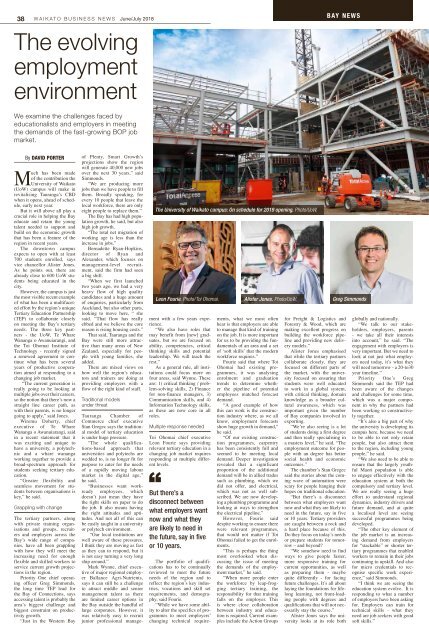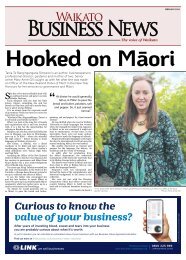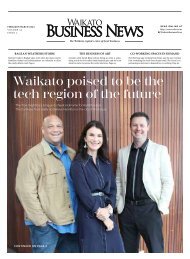Waikato Business News June/July 2018
Waikato Business News has for a quarter of a century been the voice of the region’s business community, a business community with a very real commitment to innovation and an ethos of co-operation.
Waikato Business News has for a quarter of a century been the voice of the region’s business community, a business community with a very real commitment to innovation and an ethos of co-operation.
- No tags were found...
Create successful ePaper yourself
Turn your PDF publications into a flip-book with our unique Google optimized e-Paper software.
38 WAIKATO BUSINESS NEWS <strong>June</strong>/<strong>July</strong> <strong>2018</strong><br />
BAY NEWS<br />
The evolving<br />
employment<br />
environment<br />
We examine the challenges faced by<br />
educationalists and employers in meeting<br />
the demands of the fast-growing BOP job<br />
market.<br />
By DAVID PORTER<br />
Much has been made<br />
of the contribution the<br />
University of <strong>Waikato</strong><br />
(UoW) campus will make in<br />
revitalising Tauranga’s CBD<br />
when it opens, ahead of schedule,<br />
early next year.<br />
But it will above all play a<br />
crucial role in helping the Bay<br />
educate and retain the young<br />
talent needed to support and<br />
build on the economic growth<br />
that has been a feature of the<br />
region in recent years.<br />
The downtown campus<br />
expects to open with at least<br />
700 students enrolled, says<br />
vice chancellor Alister Jones.<br />
As he points out, there are<br />
already close to 600 UoW students<br />
being educated in the<br />
city.<br />
However, the campus is just<br />
the most visible recent example<br />
of what has been a multifaceted<br />
effort by the region’s unique<br />
Tertiary Education Partnership<br />
(TEP) to collaborate closely<br />
on meeting the Bay’s tertiary<br />
needs. The three key partners<br />
- the UoW, Te Whare<br />
Wananga o Awanuiarangi, and<br />
the Toi Ohomai Institute of<br />
Technology - recently signed<br />
a renewed agreement to continue<br />
what has been several<br />
years of productive cooperation<br />
aimed at responding to a<br />
changing job market.<br />
“The current generation is<br />
really going to be looking at<br />
multiple jobs over their careers,<br />
so the notion that there’s now a<br />
straight line career path, as<br />
with their parents, is no longer<br />
going to apply,” said Jones.<br />
Wiremu Doherty, chief<br />
executive of Te Whare<br />
Wananga o Awanuiarangi, said<br />
in a recent statement that it<br />
was exciting and unique to<br />
have a university, a polytechnic<br />
and a whare wananga<br />
working together to provide a<br />
broad-spectrum approach for<br />
students seeking tertiary education.<br />
“Greater flexibility and<br />
seamless movement for students<br />
between organisations is<br />
key,” he said.<br />
Grappling with change<br />
The tertiary partners, along<br />
with private training organisations<br />
and groups, recruiters<br />
and employers across the<br />
Bay’s wide range of companies,<br />
have all been grappling<br />
with how they will meet the<br />
increasing need for enough<br />
flexible and skilled workers to<br />
service current growth projections<br />
in the region.<br />
Priority One chief operating<br />
officer Greg Simmonds,<br />
the long time TEP lead for<br />
the Bay of Connections, says<br />
accessing talent is probably the<br />
area’s biggest challenge and<br />
biggest constraint on productivity<br />
growth.<br />
“Just in the Western Bay<br />
of Plenty, Smart Growth’s<br />
projections show the region<br />
will generate 40,000 new jobs<br />
over the next 30 years,” said<br />
Simmonds.<br />
“We are producing more<br />
jobs than we have people to fill<br />
them. Broadly speaking, for<br />
every 10 people that leave the<br />
local workforce, there are only<br />
eight people to replace them.”<br />
The Bay has had high population<br />
growth, he said, but also<br />
high job growth.<br />
“The total net migration of<br />
working age is less than the<br />
increase in jobs.”<br />
Bernadette Ryan-Hopkins,<br />
director of Ryan and<br />
Alexander, which focuses on<br />
management-level recruitment,<br />
said the firm had seen<br />
a big shift.<br />
“When we first launched<br />
two years ago, we had a very<br />
heavy flow of high quality<br />
candidates and a huge amount<br />
of enquiries, particularly from<br />
Auckland, but also other parts,<br />
looking to move here, “ she<br />
said. “That flow has really<br />
ebbed and we believe the core<br />
reason is rising housing costs.”<br />
That said, Tauranga and the<br />
Bay were still more attractive<br />
than many areas of New<br />
Zealand, especially for people<br />
with young families, she<br />
added.<br />
There are mixed views on<br />
how well the region’s educators<br />
and trainers are doing at<br />
providing employers with a<br />
flow of the right kind of staff.<br />
Traditional models<br />
under threat<br />
The University of <strong>Waikato</strong> campus: On schedule for 2019 opening. Photo/UoW.<br />
Leon Fourie. Photo/Toi Ohomai. Alister Jones. Photo/UoW. Greg Simmonds<br />
Tauranga Chamber of<br />
Commerce chief executive<br />
Stan Gregec says the traditional<br />
model of tertiary education<br />
is under huge pressure.<br />
“The whole qualifications-based<br />
approach that<br />
universities and polytechs are<br />
wedded to, is no longer fit for<br />
purpose to cater for the needs<br />
of a rapidly moving labour<br />
market in the digital age,”<br />
he said.<br />
“<strong>Business</strong>es want workready<br />
employees, which<br />
doesn’t just mean they have<br />
the right skills on paper to do<br />
the job. It also means having<br />
the right attitudes and aptitudes.<br />
And not all of this can<br />
be easily taught in a university<br />
or polytech environment.<br />
“Our local institutions are<br />
well aware of these pressures.<br />
I think they are moving as fast<br />
as they can to respond, but it<br />
is not easy turning a very long<br />
ship around.”<br />
Mark Wynne, chief executive<br />
of major regional employer<br />
Ballance Agri-Nutrients,<br />
says it can still be a challenge<br />
to attract middle and senior<br />
management talent as there<br />
are limited career options in<br />
the Bay outside the handful of<br />
large corporates. However, it<br />
was relatively easy to recruit<br />
junior professional management<br />
with a few years experience.<br />
“We also have roles that<br />
may benefit from [new] graduates,<br />
but we are focused on<br />
ability, competencies, critical<br />
thinking skills and potential<br />
leadership. We will teach the<br />
rest.”<br />
As a general rule, all institutions<br />
could focus more on<br />
four areas, said Wynne. These<br />
are: 1) critical thinking / problem-solving<br />
skills, 2) Finance<br />
for non-finance managers, 3)<br />
Communication skills, and 4)<br />
Information Technology skills,<br />
as these are now core in all<br />
roles.<br />
Multiple response needed<br />
Toi Ohomai chief executive<br />
Leon Fourie says providing<br />
relevant tertiary education in a<br />
changing job market requires<br />
responding at multiple different<br />
levels.<br />
But there’s a<br />
disconnect between<br />
what employers want<br />
now and what they<br />
are likely to need in<br />
the future, say in five<br />
or 10 years.<br />
The portfolio of qualifications<br />
has to be continually<br />
reviewed to meet the future<br />
needs of the region and to<br />
reflect the region’s key industries,<br />
vocations and skill set<br />
requirements, and demography,<br />
said Fourie.<br />
“While we have some ability<br />
to alter the specifics of programmes<br />
to meet employers’<br />
changing technical requirements,<br />
what we most often<br />
hear is that employers are able<br />
to manage that kind of training<br />
on the job. It is more important<br />
for us to be providing the fundamentals<br />
of an area and a set<br />
of ‘soft skills’ that the modern<br />
workforce requires.”<br />
Fourie said that where Toi<br />
Ohomai had existing programmes,<br />
it was analysing<br />
enrolment and graduation<br />
trends to determine whether<br />
the pipeline of potential<br />
employees matched forecast<br />
demand.<br />
“A good example of how<br />
this can work is the construction<br />
industry where, as we all<br />
know, employment forecasts<br />
show huge growth in demand,”<br />
he said.<br />
“Of our existing construction<br />
programmes, carpentry<br />
has been consistently full and<br />
seemed to be meeting local<br />
demand. Deeper investigation<br />
revealed that a significant<br />
proportion of the additional<br />
demand will be in allied trades<br />
such as plumbing, which we<br />
did not offer, and electrical,<br />
which was not as well subscribed.<br />
We are now developing<br />
a plumbing programme and<br />
looking at ways to strengthen<br />
the electrical pipeline.”<br />
However, Fourie said<br />
despite working to ensure there<br />
were relevant programmes,<br />
that would not matter if Toi<br />
Ohomai failed to get the enrolments.<br />
“This is perhaps the thing<br />
most overlooked when discussing<br />
the issue of meeting<br />
the demands of the employment<br />
market,” he said.<br />
“When more people enter<br />
the workforce by leap-frogging<br />
tertiary training, the<br />
responsibility for that training<br />
falls on the employer. This<br />
is where close collaboration<br />
between industry and education<br />
is required. Current examples<br />
include the Action Groups<br />
for Freight & Logistics and<br />
Forestry & Wood, which are<br />
making excellent progress on<br />
building the workforce pipeline<br />
and providing new delivery<br />
models.”<br />
Alister Jones emphasised<br />
that while the tertiary partners<br />
collaborate closely, they are<br />
focused on different parts of<br />
the market, with the university<br />
focused on ensuring that<br />
students were well educated<br />
to work in a global system,<br />
with critical thinking, domain<br />
knowledge as a broader cultural<br />
awareness, which was<br />
important given the number<br />
of Bay companies involved in<br />
exporting.<br />
“We’re also seeing is a lot<br />
of students doing a first degree<br />
and then really specialising in<br />
a masters level,” he said. “The<br />
employment outcome for people<br />
with an degree has better<br />
social health and economic<br />
outcomes.”<br />
The chamber’s Stan Gregec<br />
said the stories about the coming<br />
wave of automation were<br />
scary for people hanging their<br />
hopes on traditional education.<br />
“But there’s a disconnect<br />
between what employers want<br />
now and what they are likely to<br />
need in the future, say in five<br />
or 10 years. Tertiary providers<br />
are caught between a rock and<br />
a hard place because of this.<br />
Do they focus on today’s needs<br />
or prepare students for tomorrow<br />
– and beyond?<br />
“We somehow need to find<br />
ways to give people faster,<br />
more responsive training for<br />
current opportunities, as well<br />
as preparing them - maybe<br />
quite differently - for facing<br />
future challenges. It’s all about<br />
laying the foundations for lifelong<br />
learning, not front-loading<br />
people with degrees and<br />
qualifications that will not necessarily<br />
stay the course.”<br />
Alister Jones says the university<br />
looks at its role both<br />
globally and nationally.<br />
“We talk to our stakeholders,<br />
employers, parents<br />
- we take all their interests<br />
into account,” he said. “The<br />
engagement with employers is<br />
very important. But we need to<br />
look at not just what employers<br />
need today, it’s what they<br />
will need tomorrow - a 20-to30<br />
year timeline.”<br />
Priority One’s Greg<br />
Simmonds said the TEP had<br />
been aware of the changes<br />
and challenges for some time,<br />
which was a major component<br />
in why the partners had<br />
been working so constructively<br />
together.<br />
“It’s also a big part of why<br />
the university is developing its<br />
campus here, because we need<br />
to be able to not only retain<br />
people, but also attract them<br />
to the region, including young<br />
people,” he said.<br />
“We also need to be able to<br />
ensure that the largely youthful<br />
Maori population is able<br />
to engage effectively with the<br />
education system at both the<br />
compulsory and tertiary level.<br />
We are really seeing a huge<br />
effort to understand regional<br />
dynamics, industry drivers and<br />
future demand, and at quite<br />
a localised level are seeing<br />
successful programmes being<br />
developed.<br />
“The other key element of<br />
the job market is an increasing<br />
demand from employers<br />
for “stackable” or shorter tertiary<br />
programmes that enabled<br />
workers to remain in their jobs<br />
continuing to upskill. And also<br />
for micro credentials to recognise<br />
specific work experience,”<br />
said Simmonds.<br />
“I think we are seeing the<br />
education system evolve. It is<br />
responding to what a number<br />
of employers have been asking<br />
for. Employers can train for<br />
technical skills - what they<br />
need are job seekers with good<br />
soft skills.”


















